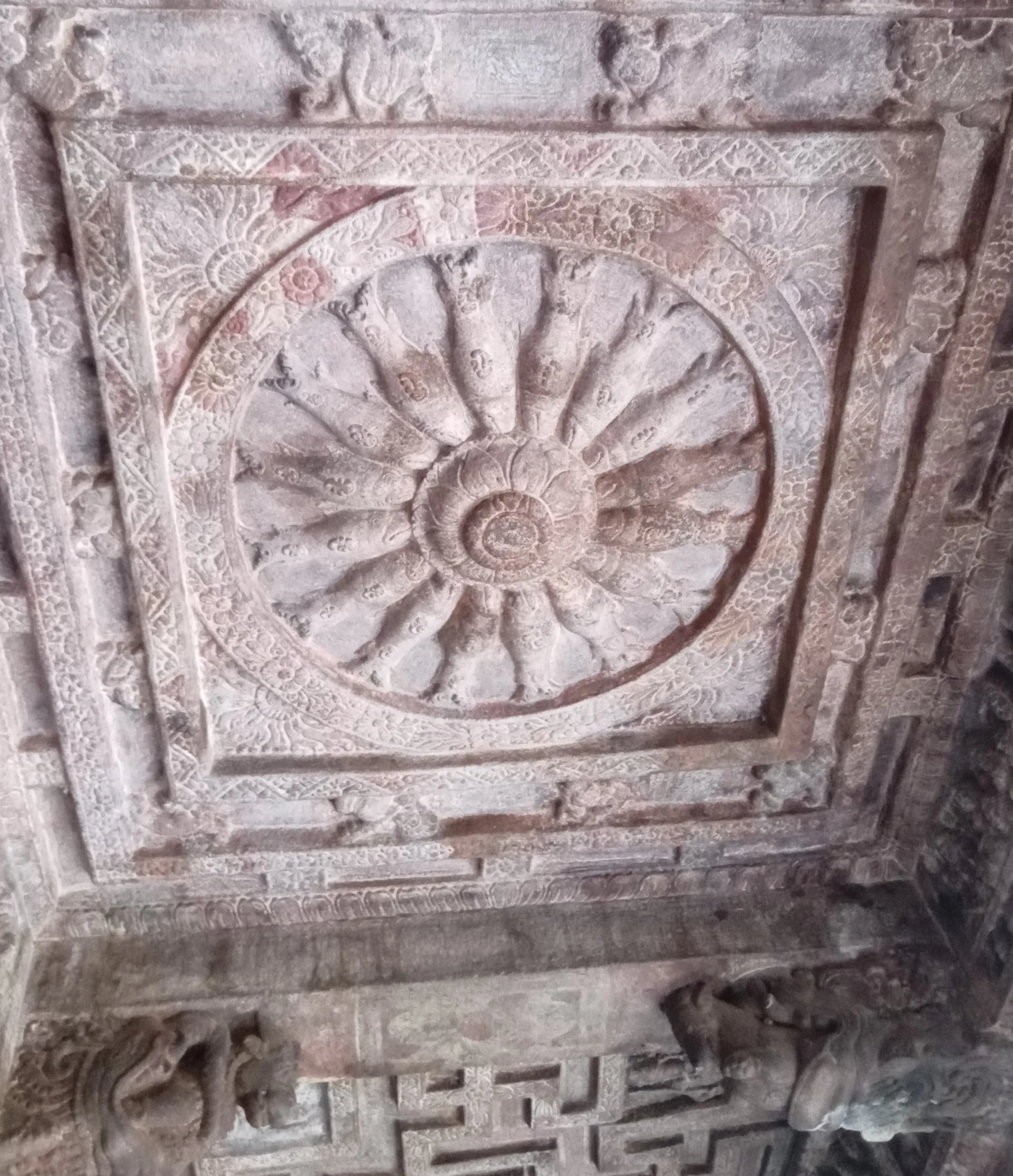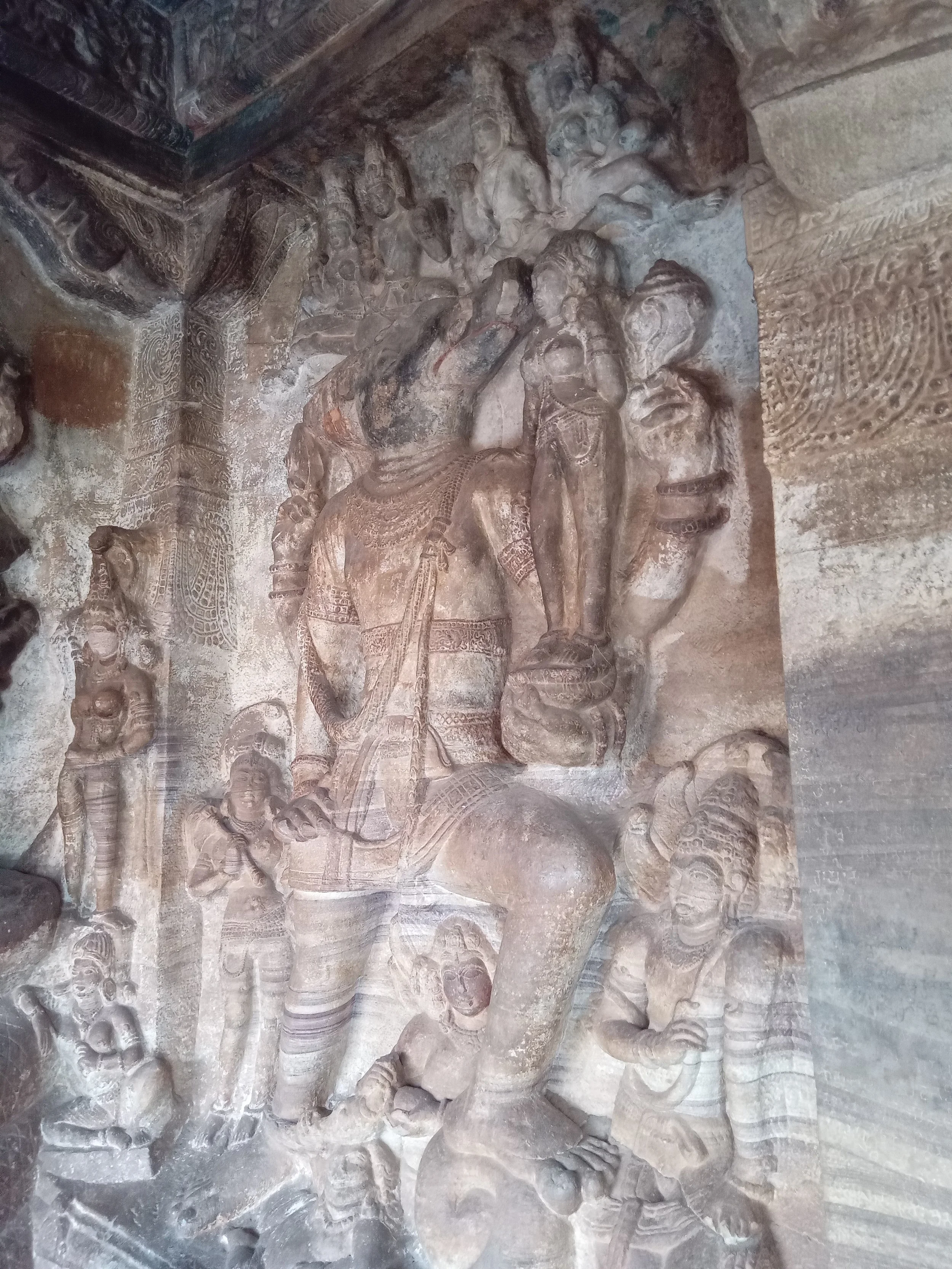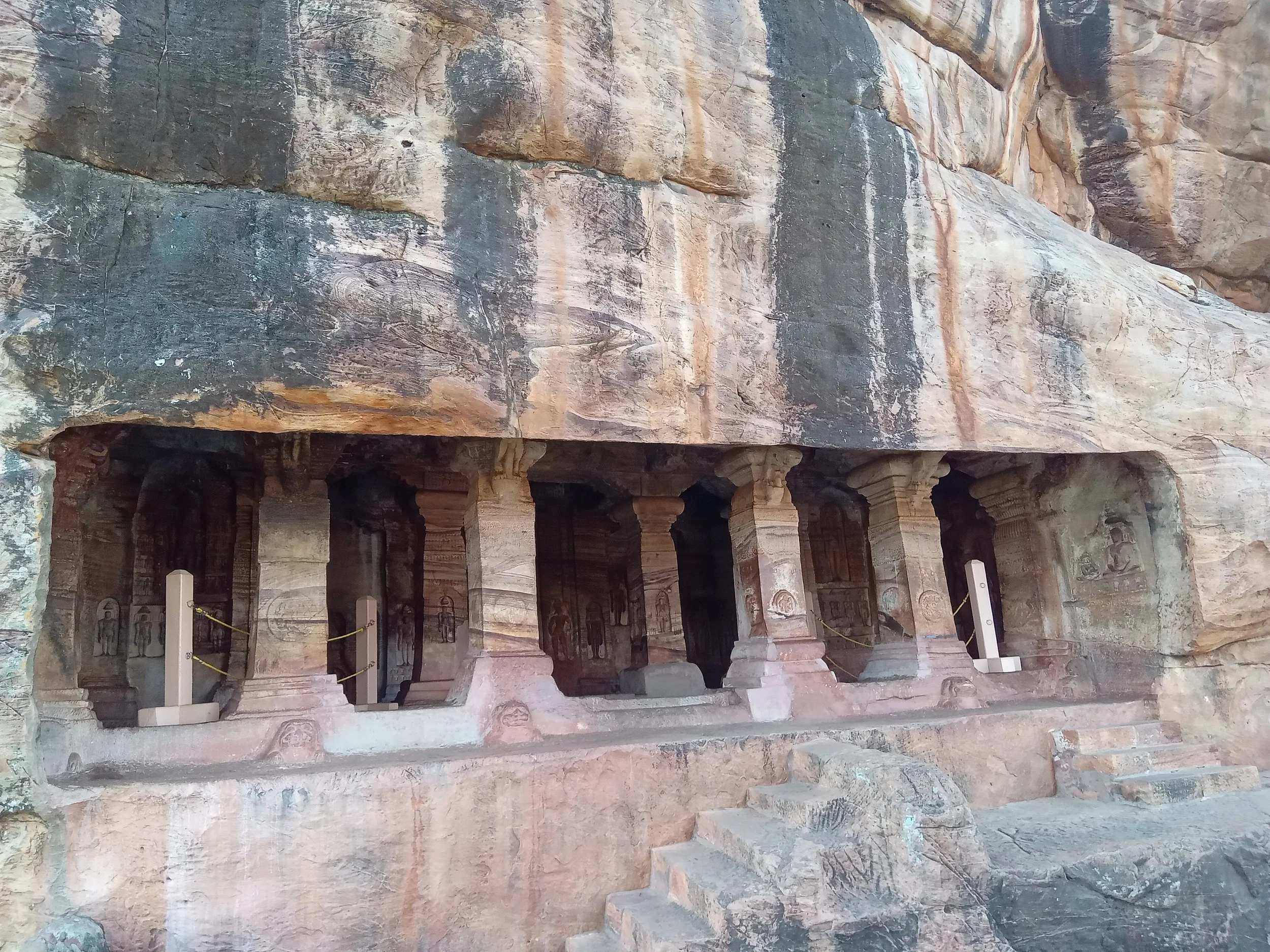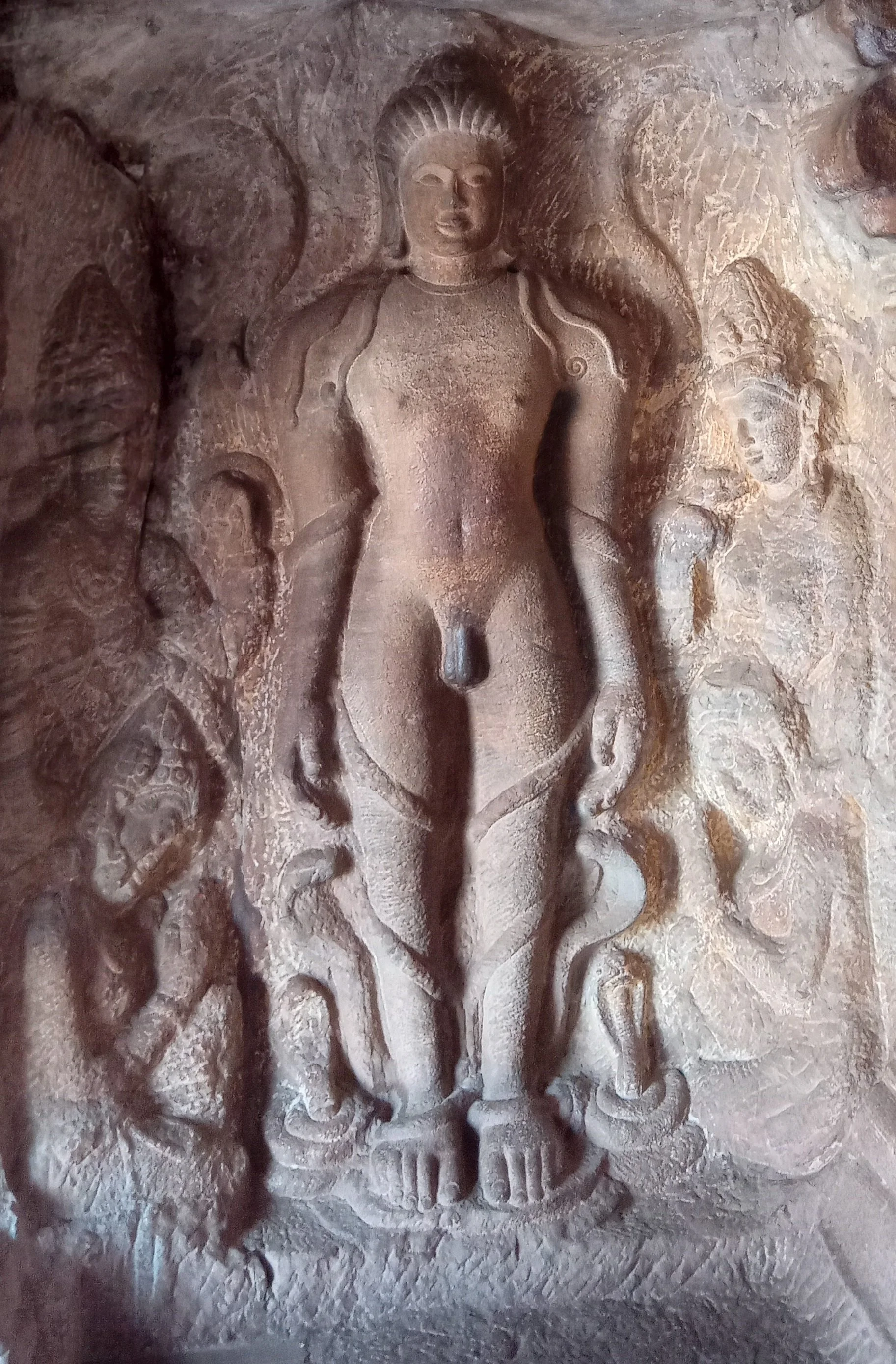Badami caves
Note: the images included here are my own work unless otherwise credited.
The first thing we glimpsed on the way to our hotel in Badami: red sandstone bluffs in the distance. My wife said, there—we can see the caves. The next morning, we walked there. (It was a short walk sure, but the surroundings and the road were not clean, with the usual random piles of sand and gravel and puddles of water—a veritable obstacle course, so I’d recommend hopping on a tuk-tuk instead.)
After we got our tickets at the entrance, a guide approached us. My usual policy with guides: if they allow us to breathe, meaning they’re informative but also as unobtrusive as possible, a guide is a big plus. There’s no real way of knowing beforehand though what kind of a guide you’re signing up for—so maybe go with your gut feel or the need of the hour. As it turned out, we hired a guide. I am now glad we did so, because my knowledge of Hindu iconography is rudimentary at best—and before I started this journey it was worse, me being prone to making some embarrassing ID errors (mistaking Vishnu for Shiva or vice versa, not so uncommon maybe for a casual visitor, but if you look at it from the perspective of the sculptor/s of the temple in question, potentially shocking: “This is a Vishnu temple!” ). I mention this not to boast about my ignorance but to underline the fact that so many of us breeze through life without observing even surface details—art in general, and the careful craft found in the Badami caves in particular, deserves better.
Cave 1 (Shiva)
Several steps from the ticket-entrance led us to the first cave, dedicated to Shiva. (When in doubt, crosscheck with the icon in the innermost sanctuary.) There’s a nice landing platform outside the actual cave, so we could stand together and our guide could begin talking. He was telling us about the sandstone—that the rusty color of the stone resembled almond kernels, the local word for almond being badam, hence the label Badami. (This might or might not be actually true—guides notoriously repeat falsities or half-truths. For one thing, the almonds we’re used to in the modern world are the ubiquitous California kind, which account for nearly ninety percent of the world’s supply today. So whether you pick up a packet from your local Safeway in LA, or a roadside shop in the Himalayas, you’re likely looking at the same thing. So the guide’s story fits if the historical badam kernel matched the color of the California almond. But I have to say: true or no, the almond-analogy is a striking one.)
Cave 1 from outside
So from the landing one of the first things you should see, carved on the rock to your right: a magnificent life-sized eighteen-armed dancing Shiva. In other words, Nataraja deep in the throes of his cosmic dance, with palpable intensity and rapture. Notably, most Nataraja sculptures we’re used to feature multiple arms sure, but rarely so many, wielding all sorts of weapons, the hands depicting various mudras or ritual poses.
Eighteen-armed dancing Shiva
If you are somewhat of a novice about these things like me, how do we know this is Shiva (apart from blindly believing your guide)? Among other clues, note the Nandi bull on the bottom left—Shiva’s vehicle of choice—and the trishul trident held aloft in one of his eighteen arms.
You climb the steps and in a receptacle to your right is a series of three icons—this receptacle was cordoned off when we visited, but we didn’t let that discourage us as we still leaned forward and looked carefully on the wall in the darkness—Mahishasuramardini Durga spearing the buffalo demon, with Ganesha on one side, and Subrahmanya on a peacock flanking the other side of her (images courtesy Sarah Welch).
Divinities in deep receptacle at right-front of Cave 1
Next you come forward to the temple proper beyond the receptacle, and on the right side you see Ardhanarishwara—the composite aspect of Shiva, the right half of whom is male, the left half female. On the male side we see a Nandi bull, and on the female side of course a female attendant holding relevant accessories. Among other notable details here: an emaciated, repentant Bhringi with folded hands who had been cursed by Parvati.
Ardhanarishwara with emaciated, repentant Bhringi behind
From where you stand, look to the far side on the left: another composite form, namely Harihara—the right side comprising Shiva with the associated Nandi, the left side Vishnu holding the characteristic conch. Among the remarkable things about the sculptures in the Badami caves is the fairly original presentations in the iconography: very few examples here feel blindly reverting to type. This particular Harihara too feels unusual in Hindu iconography because of the prominent inclusion of the relevant consorts: Parvati beside the Shiva-half, and Lakshmi flanking the Vishnu-half.
Harihara (composite Shiva and Vishnu)—flanked by consorts on relevant side, Parvati and Lakshmi.
Now look up to the ceiling and see the coiled Naga serpent divinity (a recurring trope not just in Badami but also elsewhere in the area).
Before moving deeper into the cave, our guide pointed out this sculpture on the left wall, featuring Shiva and Parvati riding on the Nandi—reminiscent of contemporary couples on two-wheelers seen all over India (although Parvati clearly rides side-saddle Victorian-style—but I like the familiarity and tenderness in her arms on his shoulder and waist).
Shiva-Parvati out for a ride.
Beyond the seated Nandi in the center of the cave, we see a Linga in the inner sanctuary, confirming that this cave is consecrated to Shiva.
Linga in the inner sanctuary.
Last but not least, note the jeweled and foliate details on the columns as well as the fluting on the capitals.
Jeweled columns with grooved “fluting” on capitals.
Cave 2 (Vishnu)
Smaller than the first cave, and situated a little higher up the hill: but the two front relief panel sculptures on either side are no less impressive, portraying Trivikrama lifting his foot high up and Varaha holding up Bhudevi.
Cave 2 as you ascend the steps.
More about the two front panels: both forms are aspects of Vishnu. Trivikrama means “three strides”—suggest reading up on the Puranic story for more details. Equally redolent with meaning—the story of Varaha lifting up the earth.
Trivikrama (”three strides”), one of the aspects of Vishnu.
Varaha (another aspect of Vishnu, this time as a wild boar) holding up the earth (personified here as “Bhudevi”).
Look up and around to see more sculptures: a maze, a wheel with fish-spokes, and Vishnu carried on the shoulders of his vehicle of choice, Garuda (note Vishnu holding the characteristic chakra wheel and conch in his hands).
Maze
Fish-spoked wheel
Vishnu being carried by Garuda
Ornate column carvings along with octagonal fluting in the middle.
Cave 3 (Vishnu)
The largest and most ornate of all the temples here, and it doesn’t fail to make an immediate impression.
Cave 3 from outside.
Once you enter the elaborate mandapa—with visibly rich and sturdy columns—it is clear you should spend more time here than the others, as there’s so much to see. The first thing you should insist your guide show you is the inscription on one of the columns here dated Saka 500 (578 CE)—making this one of the earliest such dated Hindu shrines in South India. But otherwise your focus should mainly be twofold: on (a) the carved panels on the walls; and (b) the sundry carefully worked sculptures, mainly of couples, on the columns in between. Among (a), two especially stood out for me: Vishnu seated on the coiled serpent Sesha; and Narasimha casually leaning on a club or suchlike object. (If you’re familiar with Hindu iconography, you might recall that Vishnu is usually portrayed as reclining flat on Sesha, so seeing him seated upright here feels fresh; and I can’t recall seeing Narasimha so relaxed anywhere else.)
Seated Vishnu
Seated Vishnu, closer view
A surprisingly chill Narasimha
Eight-armed Vishnu
Harihara
And now for some charming sculptures of everyday life from the 6th century—featuring folks dressed up in regal finery as well as casual knee-length garments.
Cave 4 (Mahavira)
A compact jain cave, feels rather more austere and stark relative to the others.
Inside, note the fine sculptures of Bahubali fasting (the more colossal version of this is in Shravanabelagola), Parshvanatha and a seated, meditating Mahavira in the inner sanctuary.






























